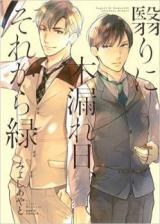I am glad that sensei didn’t carry out their original plan. While it would definitely have been much more interesting to read there was not enough space to carry out the plan in its entirety. I do believe there was a great risk of ruining this gem of a work that sensei, with others help, has been able to produce. And, I will say this as well, I think the research done did pay off well as the effort was quite clearly conveyed through the sheer brilliance of this piece.
The minute and fabulous artwork is definitely something that will keep everyone’s interest and necessitate that one read this manga with great care and patience. All the more to savour it.
To the reader who loved this, I would like to direct your attention towards Tamayura and Golden Days. Well, Golden Days doesn’t even qualify as a point of comparison given the length that it spanned. However, Tamayura, within the space of a pithy 5 chapters, was definitely able to illustrate the cruel, and unforgiving, hardships that doseiai brings forth in a patriarchal society.
Lastly, in worrying about which picture to choose that resonate with me the most and are representative of this manga’s intentions, once again during the moment I read Tamayura, it struck me that I cannot. I needed two pictures and both of them were about death; I bleed for this. Furthermore, I also thought about what kind of representation do I wish to make? My first and foremost inclination was with death and suffering, despite the joyous resolution. But, I thought back to a conversation I had, “Why must women die? What sort of agency is this?” And, while I gave an answer it did feel inadequate to me though I did feel that I was simply circling around something that I did not wish to name. I did not understand this back then, but after reading this manga and having reflected on why do I feel the inclination for the pictures I do chose, I recognize now what I did not back then. The next time when someone poses a similar question to me, I shall be able to answer without any hesitation; [this oppression and victimization that is repackaged as agency with nothing except for death as our source for salvation] is a deliberate attempt of the heterosexual matrix to assert its dominance. To erase our existence. To say to us, “Here. Look, you are represented here. It’s unfortunate that you die, you don’t have to, but that’s what we are working with right now. Sorry.”
There is deliberate maliciousness and an active, sustained, force of erasure behind our deaths. Death cannot be the only manner of our celebration and memorialization. We must not allow for this to happen. A lot of our time is spent in imaging ourselves, imaging ourselves whole, exactly because the patriarch either does not accept our existence as humans, or accepts our existence only when presented with our cadavers. I repeat: we must not allow for this to happen. As Sara Ahmed says, “we must stay unhappy with this world” (Ahmed 2010). As such, the joy, the sheer indescribable and uncontainable, joy that I now cradle within on having read the ending panel, is my sustenance. That is why even though I still feel a strong attraction to those two panels of death, in learning to rearrange my desires, I shall go with the last panel. The panel about which I am quite ambivalent, even as I know that it is my source of sustenance.
Maybe sensei had not considered all of this when drawing the last panel, however, and I will say this, you honestly don’t have to if you know that it is a happy end that you wish to create. I would assert that as long as one is empathetic then it is a positive reaction that one will find.





